If you have been on an African safari, chances are, you have heard the term “Big Five”. So, what are the Big Five?
The “Big Five” refers to Africa’s most iconic large mammals: elephants, lions, leopards, buffaloes, and rhinoceroses. The term “Big Five” was originally used by big-game hunters to refer to the five most difficult animals to hunt on foot in the African jungle. It is for this reason that the Big Five are also called the “Big Five Game”.
In modern times, the Big Five have become a symbol of Africa’s diverse and rich wildlife. Tourists from around the world visit African game reserves to witness these magnificent creatures in their natural habitats.
In Africa, Kenya’s most famous reserve, the Masai Mara, is home to the Big Five. Also, in northern Kenya, specifically Lake Nakuru, Lewa Wilderness Conservancy, and Ol Pejeta Conservancy, some of the members of the Big Five can be spotted.
Unveiling the Big Five Animals of the African Wilderness
Embarking on a safari to catch a glimpse of the Big Five has become a bucket-list adventure for many nature lovers, photographers, and adventure seekers. Whether you’re planning a safari or just want to get to know these wonderful creatures, here is your complete guide to the Big Five animals of the African wilderness:
Elephant (Loxodonta africana): The Earth’s Largest Land Mammal
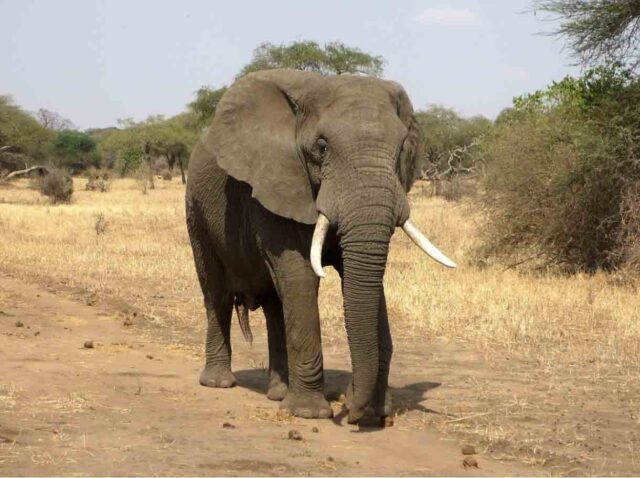
Rumbling through the savannahs with grace and might, the African Elephant, is the largest land mammal on Earth. With colossal tusks and large, flapping ears, these gentle giants roam across the vast landscapes of Africa, leaving an indelible mark on the continent’s diverse ecosystems. Elephants are revered for their intelligence, memory, and close-knit family bonds. Safari-goers are captivated by the sight of these gentle giants roaming the savannah or trumpeting at watering holes.
Lion (Panthera leo): The Proud King of the Jungle
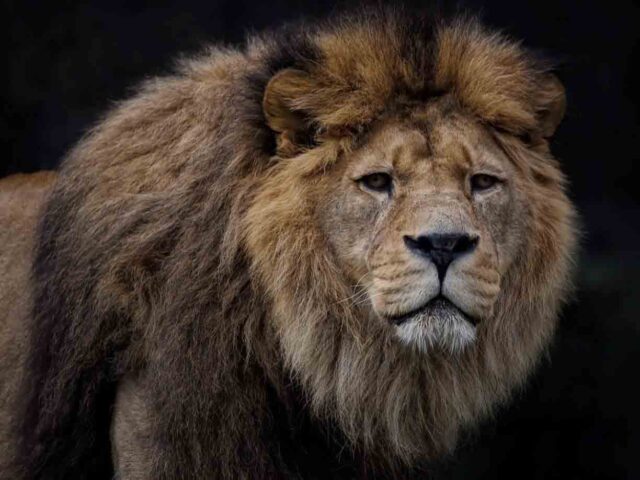
Known as the “King of the Jungle, the lion is the only social big cat, living in groups called pride. It commands respect with its majestic mane and powerful presence. These apex predators exhibit a social structure, usually consisting of related females and their young, led by a dominant male. Lions are skilled hunters,. They rely on teamwork and strategic planning to secure their prey. Symbolizing strength and courage, these majestic creatures are iconic symbols of Africa’s untamed beauty.
Cape Buffalo (Syncerus caffer): The Formidable Horned Grazers
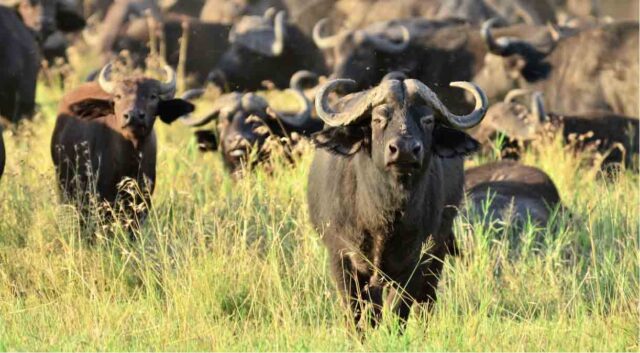
The Cape buffalo, also known as the African buffalo, is a formidable herbivore renowned for its robust build and massive, curved horns. These herbivores are often seen in large herds. They traverse the savannahs and grasslands in groups displaying a communal defense mechanism that makes them a force to be reckoned with. Despite their seemingly docile demeanor, Cape Buffaloes are known for their unpredictable nature, making encounters with these horned giants both thrilling and challenging for safari enthusiasts.
Leopard (Panthera pardus): The Stealthy Spotted Stalkers
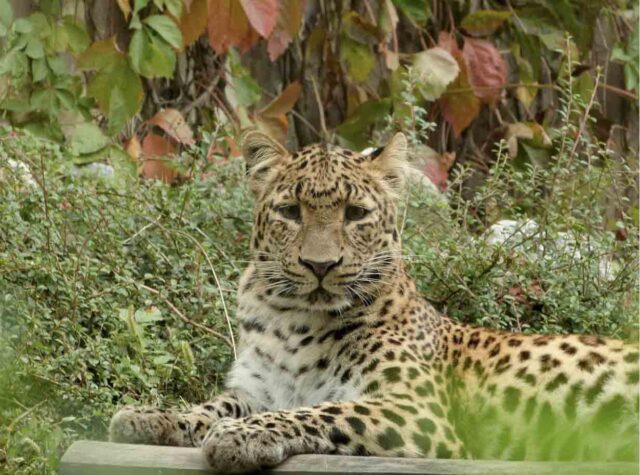
When it comes to stealth and agility, the leopard takes center stage. These solitary and elusive big cats are adorned with striking rosette-patterned coats which allow them to seamlessly blend into their surroundings. Renowned for their adaptability and climbing prowess, leopards are equally at home in trees as they are on the ground. Masters of ambush hunting, these nocturnal predators strike with precision and grace, making them a captivating and elusive sight in the African wilderness.
Rhinoceros (Diceros bicornis and Ceratotherium simum): The Dual-horned Guardians of the Grasslands
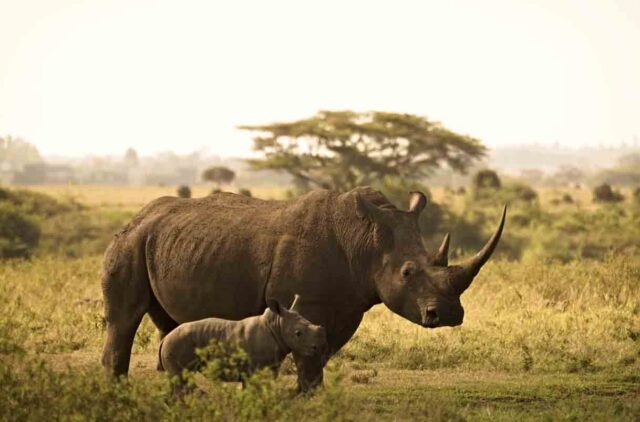
Wrapping up the prestigious Big Five list, the rhinoceros comprises two distinct species: the Black Rhinoceros (Diceros bicornis) and the White Rhinoceros (Ceratotherium simum). Rhinos are armed with formidable horns and robust builds. They play a crucial role in shaping the African ecosystems. Unfortunately, these magnificent creatures face threats from poaching and habitat loss, making their conservation a pressing concern. Distinguishing between the black and white rhinos goes beyond their color; it pertains to their lip shape, behavior, and preferred habitats, adding layers of intrigue to these ancient behemoths.
Planning Your Big Five Safari
Choose Your Destination: Africa offers a variety of safari destinations, each with its unique landscapes and wildlife. Popular choices include the Serengeti National Park in Tanzania, Kruger National Park in South Africa, and, of course, the Maasai Mara National Reserve in Kenya.
Select the Right Time: Wildlife viewing can vary depending on the time of year. The dry season, usually during the winter months, is often considered the best time for safaris as animals gather around water sources, providing excellent viewing opportunities.
Accommodation Options: From luxury lodges to tented camps, there’s a range of accommodation options to suit various preferences and budgets. Many lodges are strategically located near wildlife hotspots, ensuring an immersive safari experience.
Guided Tours vs. Self-Drive: Choose between guided tours led by experienced safari guides or self-drive options. Guided tours offer expert knowledge, while self-drive options provide flexibility for those who prefer a more independent adventure.
Pack Accordingly: Safaris often involve long drives and exposure to the elements. Pack comfortable clothing, a hat, sunscreen, sturdy walking shoes, and a good pair of binoculars to enhance your wildlife-viewing experience.
Where to Find the Big Five in Kenya?
Kenya is a premier destination for witnessing the majestic Big Five in their natural habitats. Here are some of the prime locations within Kenya where you can embark on a thrilling safari to encounter these iconic creatures:
Maasai Mara National Reserve: One of Africa’s most spectacular wildlife destinations, Maasai Mara is a vast savannah teeming with diverse wildlife. The reserve offers an exceptional chance to witness the Big Five, especially during the annual Great Migration when millions of wildebeest and other herbivores traverse the Mara River.
Lake Nakuru National Park: Nestled in the Great Rift Valley, Lake Nakuru is a haven for birdwatchers and wildlife enthusiasts. While the park is famous for its vibrant flamingo population, it also hosts both white and black rhinoceros, completing the Big Five ensemble.
Lewa Wilderness Conservancy: Situated to the north of Mount Kenya, Lewa is a private conservancy committed to wildlife conservation. Visitors can spot all members of the Big Five, including the critically endangered black rhinoceros. The conservancy’s unique landscape adds an extra dimension to the safari experience.
Ol Pejeta Conservancy: Located in Nanyuki town at the foothills of Mount Kenya, Ol Pejeta is renowned for its conservation efforts, including the protection of both black and white rhinoceros. The conservancy also provides a home for rescued chimpanzees and offers a unique blend of wildlife experiences.
Tsavo East and West National Parks: The two parks form the largest protected area in Kenya and host most of the larger animals, including the red elephant, rhino, leopard, hippo, crocodile, waterbucks, and over 500 different bird species.
Amboseli National Park: Amboseli is one of the most popular parks in Kenya. It offers a great opportunity to view all of the members of the Big Five.
Conclusion
A Big Five safari promises a breathtaking opportunity to witness Africa’s iconic animal species in their natural species. Although most Kenyan Parks do allow the use of small vehicles such as Honda Vezel, Mazda CX-5, Honda Civic and others, Big 5 safaris are best done using the 4×4 safari land cruiser prado. Get ready to embark on this adventure and get up close and personal with the beauty of the African wilderness.









